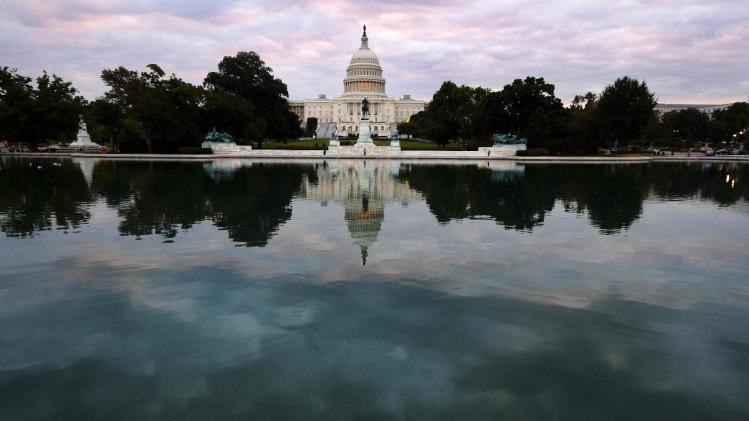Analysis: Partisan society, gridlocked Congress
WASHINGTON (AP) — It's not news that Congress is gridlocked. What's increasingly striking is that both parties are nearly unanimous in their stands, with each one seemingly certain that its position is totally right and the other's is totally wrong.
That would seem to defy common sense. After all, most Americans either want a higher minimum wage or they don't. They want to extend unemployment benefits and repeal "Obamacare" or they don't.
Isn't one party in danger of falling out of step? For instance, is the congressional Republicans' near-solid opposition to a higher federal minimum wage risky, given that three-fourths of Americans say they support it?
No, say lawmakers and congressional scholars.
Increasingly, elected Republicans and Democrats speak to constituencies separated by geography and partisan convictions. This ongoing self-segregation into conservative and liberal enclaves is shrinking the political middle that once made compromise more attainable and the parties more ideologically diverse.
The results play out almost every week in Congress. Republicans repeatedly vote to repeal the president's health care law. Democrats push to raise the minimum wage even when they know Senate Republicans will block it.
The great majority of Republicans today are elected from solidly conservative districts and states. And the great majority of Democrats are elected from reliably liberal districts and states.
If congressional Democrats and Republicans seem to speak different languages, it's because they speak the political languages of their electoral homes. Simply put, "they represent their constituents," said Gary Jacobson, a political scientist at the University of California, San Diego.
Democratic President Barack Obama twice won national majorities, Jacobson said, but Republicans control the House because their voters "are distributed more efficiently across districts."
Of course, congressional Democrats and Republicans have clashed over policy for decades. But in the not-so-distant past they had sizable numbers of moderates to challenge party leaders and pull the parties closer to each other.
The current Congress is the most polarized since at least 1982, when National Journal began analyzing lawmakers' votes, the publication says. The most liberal Republican senator is to the right of the most conservative Democratic senator.
In the 435-member House, National Journal reported, only two Democrats were more conservative than a Republican. And only two Republicans were more liberal than a Democrat.
By contrast 20 years ago, 34 senators and 252 House members had voting records that put them between the most liberal Republican and the most conservative Democrat.
Those days are essentially gone. Congress' increasingly clear-cut partisan divisions reflect a mobile society in which liberals tend to congregate in cities and on the coasts, and conservatives dominate vast swaths elsewhere. The widespread gerrymandering of House districts amplifies the political trend.
Meanwhile, Americans are becoming more consistently partisan in their voting. There are fewer ticket-splitters who, for example, will vote Democratic for president and Republican for Senate, or vice versa. Jacobson, who tracks the issue, says state-level straight-ticket voting for president and for senator is now the highest since the 1950s.
The two major parties also are more clearly liberal and conservative, respectively.
In 1980 exit polls, 72 percent of self-described liberals said they voted for a Democratic House candidate. By 2012, the proportion was 86 percent. Conversely, two-thirds of self-described conservatives voted Republican in their 1980 House races. In 2012, 82 percent did so.
In firmly liberal or conservative House districts, the elections that really matter are the party primaries, where strongly ideological voters play outsized roles. This encourages Republican lawmakers to veer hard right, and Democrats to veer hard left, to discourage challenges from their political flanks.
Perhaps, then, it's not surprising that Congress now struggles to do once-routine tasks, such as passing a budget and paying the nation's bills by raising the debt ceiling.
Congress has raised the minimum wage seven times since 1988, to $7.25 an hour. Now, a Democratic bid to raise it to $10.10 faces nearly unanimous Republican opposition. Democrats cite national polls showing widespread support and predict Republicans will pay in midterm elections.
"This issue really resonates with the American people," said Sen. Tom Harkin, D-Iowa. Former GOP presidential nominee Mitt Romney endorses a higher minimum wage. But most Republican lawmakers shrug it off, saying there's little enthusiasm among their supporters.
Polls show that national support for a higher minimum wage is broad but not intense. In an AP-NORC Center poll that asked people to list the top 10 issues they'd like government to address, 52 percent mentioned the health care overhaul. Only 7 percent named the minimum wage or other wage issues


No comments:
Post a Comment
Thanks for commenting. Your comments are needed for helping to improve the discussion.